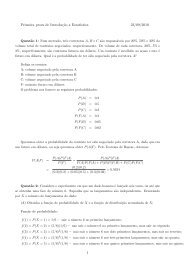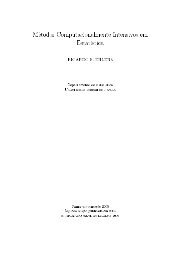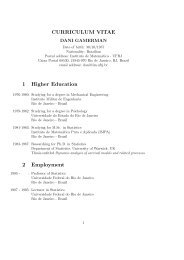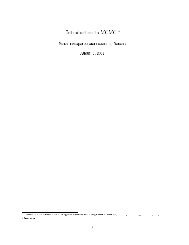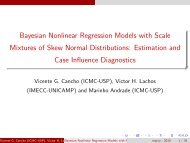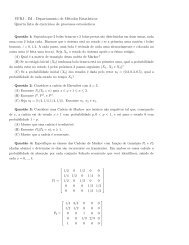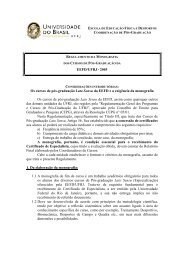Copulas: a Review and Recent Developments (2007)
Copulas: a Review and Recent Developments (2007)
Copulas: a Review and Recent Developments (2007)
Create successful ePaper yourself
Turn your PDF publications into a flip-book with our unique Google optimized e-Paper software.
2.4 Time dependent copulasIn practice, a powerful tool to specify the underlying model are the conditional distributionswith respect to the past observations. They are more useful than the jointor marginal unconditional distributions <strong>and</strong> have become a st<strong>and</strong>ard tool in ¯nance<strong>and</strong> insurance, see Embrechts et al. (2002), Cherubini et al. (2004), Patton (2006),Fermanian <strong>and</strong> Scaillet (2005), Fermanian <strong>and</strong> Wegkamp (2004). The reason is thepresence of temporal dependencies in returns of stock indices, credit spreads or interestrates of various maturities, etc.In Finance <strong>and</strong> Economics, it is often necessary to simulate the future values ofsome market factor, say S, atvariousdatest>0. Knowing the spot value S 0 today,future realizations of S t given S 0 have to be simulated. Therefore, the dependencefunction C 0;t (:jS 0 ) needs to be speci¯ed. A ¯rst attempt to formalize the functionC 0;t (:jS 0 ) for a ¯xed horizon t is due to Patton (2006) who introduced the conditionalcopula in bivariate case as follows.De¯nition (conditional bivariate copula, Patton (2006)). Let X; Y <strong>and</strong> W becontinuous r<strong>and</strong>om variables. The conditional copula of (X; Y )jW ,whereXjW » F W<strong>and</strong> Y jW » G W , is the conditional joint distribution function of U = F (XjW ) »U(0; 1) <strong>and</strong> V = G(V jW ) » U(0; 1) given W .Therefore, the conditional bivariate copula is the joint distribution of two conditionallyU(0; 1) r<strong>and</strong>om variables. In general, the n-dimensional conditional copulais derived from any distribution function such that the conditional joint distributionof the ¯rst n variables is a copula for all values of the conditioning variables. It issimple to show that conditional copula satis¯es the properties similar to the usualcopula. The following version of Sklar's theorem holds.Sklar's Theorem (for conditional bivariate copula, Patton (2006)). Let H Wbe the joint conditional distribution function with marginal distribution of (X; Y )jW .Let F W be the conditional distribution of XjW <strong>and</strong> G W be the conditional distributionof Y jW . Assume X <strong>and</strong> Y are continuous in x <strong>and</strong> y. Then there exists a uniqueconditional copula C W such thatH W (x; yjw) =C W (F W (xjw);G W (yjw)jw) for all (x; y) 2 [¡1; 1] 2 <strong>and</strong> each w 2 −:Conversely, for any conditional distribution functions F W <strong>and</strong> G W <strong>and</strong> any conditionalcopula C W , the function H W de¯ned above is a conditional two-dimensionaldistribution function with marginals F W <strong>and</strong> G W . ¥There exists a complication, coming from the assumption that the conditionalvariable W must be the same for both marginal distributions <strong>and</strong> the copula. Itfollows a supporting example.13




